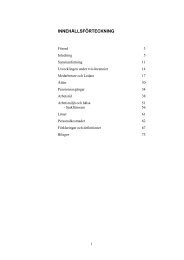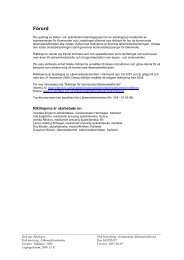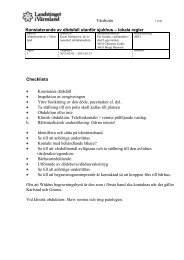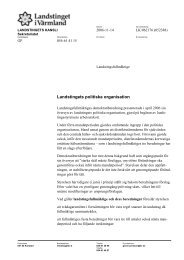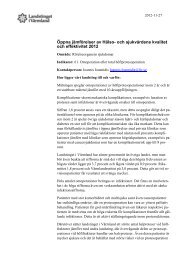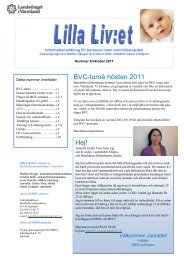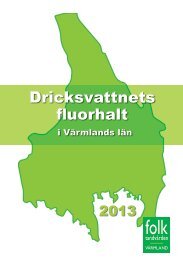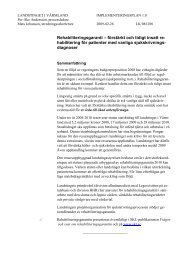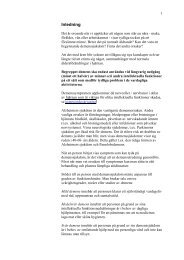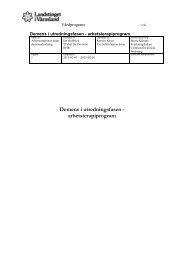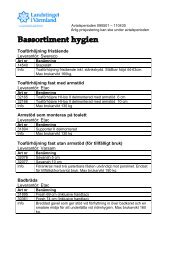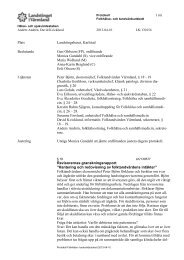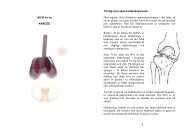Severs skada – paradigmskifte gällande diagnostik och behandling?
Severs skada – paradigmskifte gällande diagnostik och behandling?
Severs skada – paradigmskifte gällande diagnostik och behandling?
You also want an ePaper? Increase the reach of your titles
YUMPU automatically turns print PDFs into web optimized ePapers that Google loves.
Bilaga 4<br />
Scand J Med Sci Sports 2011: 21: 819<strong>–</strong>823<br />
doi: 10.1111/j.1600-0838.2010.01051.x<br />
Sever’s injury: treatment with insoles provides effective pain relief<br />
S. Perhamre 1 , S. Janson 2,3 , R. Norlin 4 , M. Kla¨ ssbo 5<br />
1 Centre of Sports Medicine in Va¨rmland, Va¨rmland County Council, Karlstad, Sweden, 2 Department of Paediatrics, Va¨rmland<br />
County Council, Karlstad, Sweden, 3 Department of Public Health, Karlstad University, Karlstad, Sweden, 4 Department of<br />
Orthopaedics, University Hospital, O¨rebro University, O¨rebro, Sweden, 5 Centre for Clinical Research, Va¨rmland County Council,<br />
Karlstad, Sweden<br />
Corresponding author: Stefan Perhamre, Idrottsha¨lsan i Va¨rmland, Kolvgatan 1 B, S-653 41 Karlstad, Sweden. Tel: 146 54 15 34 12,<br />
Fax: 146 54 15 58 98, E-mail: stefan.perhamre@liv.se<br />
Accepted for publication 7 October 2009<br />
Sever’s injury (apophysitis calcanei) is considered to be the<br />
dominant cause of heel pain among children between 8 and<br />
15 years. The traditional advice is to reduce and modify the<br />
level of physical activity. Recommended treatment in general<br />
is the same as for adults with Achilles tendon pain. The<br />
purpose of the study was to find out if insoles, of two<br />
different types, were effective in relieving heel pain in a<br />
group of boys (n 5 38) attending a Sports Medicine Clinic<br />
for heel pain diagnosed as Sever’s injury. The type of insole<br />
was randomized, and self-assessed pain during physical<br />
activity in the treatment phase with insoles was compared<br />
Sever’s injury (apophysitis calcanei, Sever’s disease)<br />
is considered to be the dominant cause of heel pain<br />
among growing children between 8 and 15 years of<br />
age, but epidemiologic data on its incidence are still<br />
lacking (McKenzie et al., 1981; Orava & Virtanen,<br />
1982; Staheli, 1998; Ogden et al., 2004; Hendrix,<br />
2005). The complaint is benign, and disappears without<br />
exception after puberty when the apophyseal<br />
growth plate is closed. The natural course is poorly<br />
studied, but the condition appears to settle within 6<strong>–</strong><br />
12 months. Occasionally, symptoms will persist for 2<br />
years (Cyriax, 1982; Brukner & Khan, 2007).<br />
The condition includes a spectrum of pain from<br />
recurrent light pain to strong pain. Boys constitute<br />
two-thirds of the patients, probably due to different<br />
physical activity preferences compared with girls of<br />
the same age (Lutter, 1992). The physical activity<br />
that appears to produce the highest levels of pain<br />
includes frequent running and jumping, and the sport<br />
that tends to dominate is soccer (Micheli et al., 1987;<br />
Madden & Mellion, 1996). Winter sports are only<br />
represented in low frequencies (Orava & Virtanen,<br />
1982; Micheli et al., 1987). The average age at onset is<br />
11<strong>–</strong>12 years (Micheli et al., 1987; Lutter, 1992).<br />
Modern literature describes Sever’s injury in terms<br />
of mechanical overuse with repetitive microtrauma<br />
36<br />
& 2010 John Wiley & Sons A/S<br />
with pain in the corresponding pre- and post-treatment<br />
phases without insoles. There were no other treatments<br />
added and the recommendations were to stay on the same<br />
activity level. All patients maintained their high level of<br />
physical activity throughout the study period. Significant<br />
pain reduction during physical activity when using insoles<br />
was found. Application of two different types of insoles<br />
without any immobilization, other treatment, or modification<br />
of sport activities results in significant pain relief in boys<br />
with Sever’s injury.<br />
to the calcaneal apophysis and its growth plate. Some<br />
authors relate the injury to forces from the Achilles<br />
tendon and the calf muscle complex, causing shear<br />
stress that compromises the apophysis (Adams &<br />
Hamblen, 1990; Volpon & de Carvalho Filho, 2002;<br />
Hendrix, 2005). Others suggest the repetitive impact<br />
force at heel strike as an alternative or complementary<br />
explanation (McKenzie et al., 1981; Orava &<br />
Virtanen, 1982; Ogden et al., 2004).<br />
The clinical findings are tenderness over the calcaneal<br />
tubercle and a positive calcaneus compression test<br />
(Micheli et al., 1987; Adams & Hamblen, 1990; Madden<br />
& Mellion, 1996; Kasser, 2006). In 40% of the<br />
cases, only one heel is affected (Micheli et al., 1987).<br />
The traditional advice is to diminish or eliminate<br />
provoking activities for a period of time. This is<br />
similar to the recommendations for treating Mb<br />
Osgood Schlatter (Hendrix, 2005). In addition, patients<br />
are recommended treatment similar to that<br />
for adults with Achilles tendon pain, most frequently<br />
including stretching, strengthening exercises for<br />
calf and extensor muscles and also NSAID treatment<br />
(Micheli et al., 1987; Lutter, 1992; Ishikawa,<br />
2005; Kasser, 2006). The importance of correcting<br />
malalignment, dominated by pronation, is stressed<br />
by some authors (Szames et al., 1990; Madden &<br />
819



